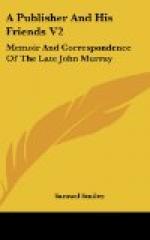A business in Liverpool, in which, with his brother, he was a partner, proved a failure, and in 1818 he was engaged on his famous “Sketch Book,” which he wrote in England, and sent to his brother Ebenezer in New York to be published there. The work appeared in three parts in the course of the year 1819. Several of the articles were copied in English periodicals and were read with great admiration. A writer in Blackwood expressed surprise that Mr. Irving had thought fit to publish his “Sketch Book” in America earlier than in Britain, and predicted a large and eager demand for such a work. On this encouragement, Irving, who was still in England, took the first three numbers, which had already appeared in America, to Mr. Murray, and left them with him for examination and approval. Murray excused himself on the ground that he did not consider the work in question likely to form the basis of “satisfactory accounts,” and without this he had no “satisfaction” in undertaking to publish.
Irving thereupon sought (but did not take) the advice of Sir W. Scott, and entered into an arrangement with Miller of the Burlington Arcade, and in February 1820 the first four numbers were published in a volume. Miller shortly after became bankrupt, the sale of the book (of which one thousand had been printed) was interrupted, and Irving’s hopes of profit were dashed to the ground. At this juncture, Walter Scott, who was then in London, came to his help.
“I called to him for help as I was sticking in the mire, and, more propitious than Hercules, he put his own shoulder to the wheel. Through his favourable representations Murray was quickly induced to undertake the future publication of the work which he had previously declined. A further edition of the first volume was put to press, and from that time Murray became my publisher, conducting himself in all his dealings with that fair, open, and liberal spirit which had obtained for him the well-merited appellation of the Prince of Booksellers.” [Footnote: Preface to the revised edition of “The Sketch Book.”]
Irving, being greatly in want of money, offered to dispose of the work entirely to the publisher, and Murray, though he had no legal protection for his purchase, not only gave him L200 for it, but two months later he wrote to Irving, stating that his volumes had succeeded so much beyond his commercial estimate that he begged he would do him the favour to draw on him at sixty-five days for one hundred guineas in addition to the sum agreed upon. And again, eight months later, Murray made Irving a second gratuitous contribution of a hundred pounds, to which the author replied, “I never knew any one convey so much meaning in so concise and agreeable a manner.” The author’s “Bracebridge Hall” and other works were also published by Mr. Murray.
In 1822 Irving, who liked to help his literary fellow-countrymen, tried to induce Mr. Murray to republish James Fenimore Cooper’s novels in England. Mr. Murray felt obliged to decline, as he found that these works were pirated by other publishers; American authors were then beginning to experience the same treatment in England which English authors have suffered in America. The wonder was that Washington Irving’s works so long escaped the same doom.




